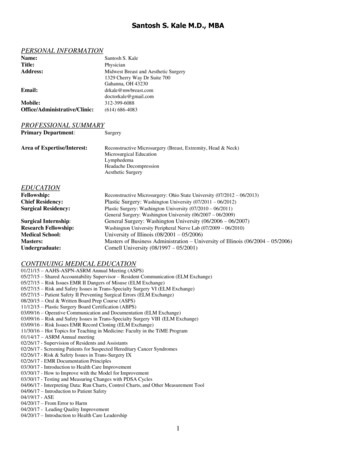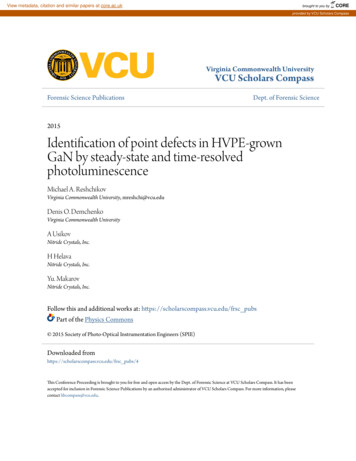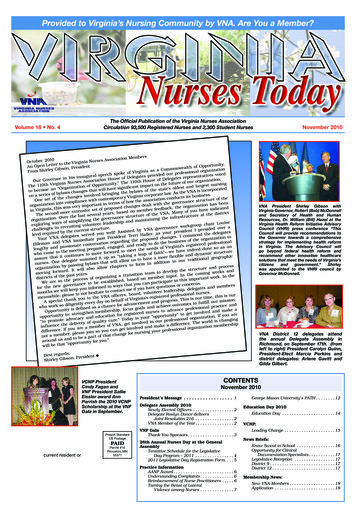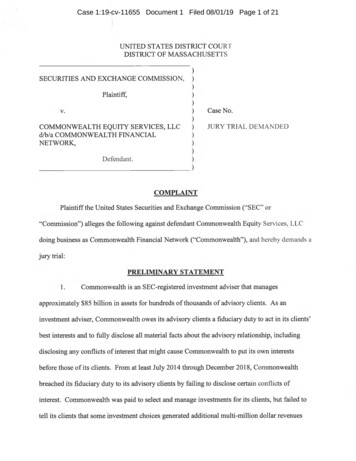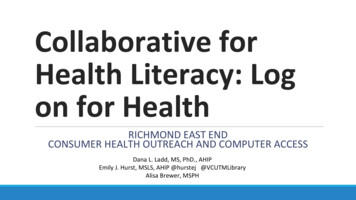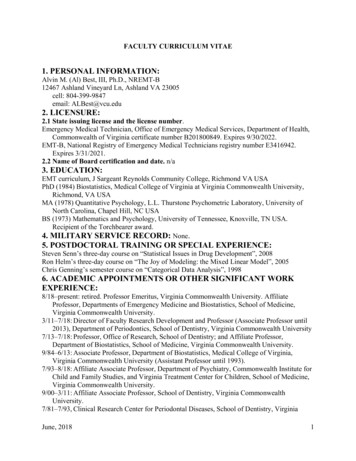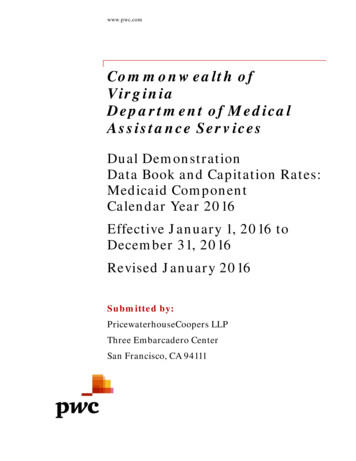
Transcription
www.pwc.comCommonwealth ofVirginiaDepartment of MedicalAssistance ServicesDual DemonstrationData Book and Capitation Rates:Medicaid ComponentCalendar Year 2016Effective January 1, 2016 toDecember 31, 2016Revised January 2016Submitted by:PricewaterhouseCoopers LLPThree Embarcadero CenterSan Francisco, CA 94111
Mr. William J. Lessard, Jr.Department of Medical Assistance Services600 East Broad Street, Suite 1300Richmond, VA 23219January 25, 2016Dear Bill:Re:Dual Demonstration Data Book and Capitation Rates –CY 2016 Effective January 1, 2016 to December 31, 2016The enclosed report provides a detailed description of the methodology used for calculating the Medicaidcomponent of the capitation rates for Calendar Year 2016, effective January 1, 2016 to December 31,2016, for the Virginia Dual Demonstration program, Commonwealth Coordinated Care. The methodsused for calculating these costs are consistent with Centers for Medicare and Medicaid Servicesrequirements for the Medicaid portion of the Financial Alignment Demonstration capitation rates.Sandra Hunt, Partner, Susan Maerki, Project Manager, and Peter Davidson, Lead Actuary, oversaw thedevelopment of these rates.Please call Sandra Hunt at 415/498-5365 if you have any questions regarding these capitation rates.Very Truly Yours,PricewaterhouseCoopers LLPPricewaterhouseCoopers LLP, 3 Embarcadero Center, San Francisco, CA 94111-4004T: (415) 498 5000, F: (415) 498 7100, www.pwc.com/us
Qualified Actuarial Certification ofCY 2016 Dual Financial Alignment Demonstration Capitation Rates:Commonwealth Coordinated CareCommonwealth of Virginia Department of Medical Assistance ServicesI, Peter B. Davidson, am associated with the firm PricewaterhouseCoopers (PwC). I am a Member of theAmerican Academy of Actuaries and meet its qualification standards to certify as to the actuarial soundness of thecalendar year 2016 capitation rates developed for the Medicaid portion of the Dual Financial Alignment Initiativeunder the Virginia Department of Medical Assistance Services (DMAS) Medicaid program.It is my qualified opinion that PwC and the Commonwealth of Virginia have developed actuarially soundMedicaid capitation rates in accordance with 42 CFR 438.6(c). The basis for the rates began with costs developedprior to the application of the Medicare and Medicaid composite savings percentages established by the State andCMS, informed by estimates from CMS and its contractors. This certification assures that the Medicaid capitatedrates were set consistent with 42 CFR 438.6(c) in combination with a qualification that the Medicare capitationrates were established by CMS and the savings percentages were established by the State and CMS. I believe thatthe capitation rates are appropriate for the populations to be covered and the services to be furnished under thecontract. The capitation rates are based solely on the projected costs for Medicaid State Plan services. Detaileddescriptions of the original methodology and assumptions used in the development of the capitation rates arecontained in the capitation rate setting report. In the development of the proposed capitation rates, I relied onenrollment, claims, and other data provided by the Virginia Department of Medical Assistance. I reviewed thedata for reasonableness; however, I performed no independent verification and take no responsibility as to theaccuracy of these data. The proposed actuarially sound rates shown are a projection of future events. It may beexpected that actual experience will vary from the values shown here. Actuarial methods, considerations, andanalyses used in developing the proposed capitation rates conform to the appropriate Standards of Practicepromulgated from time to time by the Actuarial Standards Board.The capitation rates may not be appropriate for any specific health plan. Each health plan will need to review therates in relation to the benefits provided. The health plan should compare the rates with their own experience,expenses, capital and surplus, and profit requirements prior to agreeing to contract with the State. The healthplan may require rates above, equal to, or below the proposed capitation rates. These rates represent theMedicaid portion only; total payments to plans participating in the Demonstration include separate paymentsfrom the Medicare program.Peter B. Davidson, FSAMember, American Academy of ActuariesJanuary 25, 2016DatePwCPage i
Table of ContentsI.Background1II.Data sources3III.Capitation rate calculations7IV.Programmatic and legislative adjustments8V.Trend adjustments11VI.Summary base capitation rates14VII.Memorandum of Understanding savings adjustment15VIII.CCC Demonstration rates: Medicaid component17IX.CCC Demonstration rates: Acute and Long Term Care rate components18PwCPage i
Table of ExhibitsExhibit 1aHistorical Eligibility, Fee-For-Service Claims, and Utilization Data– Nursing Home Eligible - InstitutionalExhibit 1bHistorical Eligibility, Fee-For-Service Claims, and Utilization Data– Nursing Home Eligible - WaiverExhibit 1cHistorical Eligibility, Fee-For-Service Claims, and Utilization Data – Community WellExhibit 2aPrescription Drug Rebate and Copay AdjustmentExhibit 2bNon-Emergency Transportation AdjustmentExhibit 2cAdult Day Care AdjustmentExhibit 2dHospital Inpatient AdjustmentExhibit 2eNursing Facility AdjustmentExhibit 2fPersonal Care and Respite Care AdjustmentExhibit 2gMental Health Support Services AdjustmentExhibit 2hDME Fee AdjustmentExhibit 2iIncontinence Supplies AdjustmentExhibit 2jLab Fee AdjustmentExhibit 2kEmergency Room Triage AdjustmentExhibit 2lResource Based Relative Value Scale AdjustmentExhibit 2mElderly and Disabled with Consumer Direction Overtime Payment AdjustmentExhibit 2nDMAS FFS Administrative AdjustmentExhibit 3aIBNR, Policy/Program, and Trend Adjustments for Nursing Home Eligible - InstitutionalExhibit 3bIBNR, Policy/Program, and Trend Adjustments for Nursing Home Eligible - WaiverExhibit 3cIBNR, Policy/Program, and Trend Adjustments for Community WellExhibit 4aCapitation Rate Calculations – Nursing Home Eligible - InstitutionalExhibit 4bCapitation Rate Calculations – Nursing Home Eligible - WaiverPwCPage ii
Exhibit 4cCapitation Rate Calculations – Community WellExhibit 5aBlending of Nursing Home Eligible – Institutional and Nursing Home Eligible - WaiverExhibit 5bSummary of CY 2016 Base Capitation Rates, January 2016 to December 2016Exhibit 5cComparison of CY 2015 and CY 2016 Base Capitation RatesExhibit 5dCommonwealth Coordinated Care Program Second Year Savings Percentage AdjustmentExhibit 5eSummary of CY 2016 Base Capitation Rates with 1% Second Year Savings Percentage AdjustmentExhibit 5fCommonwealth Coordinated Care Program Quality Withhold AdjustmentExhibit 5gSummary of CY 2016 Base Capitation Rates with 1% Second Year Savings Percentage Adjustmentand 2% Quality Withhold AdjustmentExhibit 6aBlending of Nursing Home Eligible – Institutional and Nursing Home Eligible – Waiver: Acuteand Long Term Care ComponentsExhibit 6bSummary of CY 2016 Base Capitation Rates: Acute and Long Term Care ComponentsExhibit 6cCommonwealth Coordinated Care Program Second Year Savings Percentage AdjustmentExhibit 6dSummary of CY 2016 Base Capitation Rates with 1% Second Year Savings Percentage Adjustment:Acute and Long Term Care ComponentsExhibit 6eCommonwealth Coordinated Care Program Quality Withhold AdjustmentExhibit 6fSummary of CY 2016 Base Capitation Rates with 1% Second Year Savings Percentage Adjustmentand 2% Quality Withhold Adjustment: Acute and Long Term Care ComponentsExhibit 7Member Months of EligiblesExhibit 8County Listing by RegionPwCPage iii
CCC Dual DemonstrationData Book and Capitation RatesCalendar Year 2016Effective January 1, 2016 to December 31, 2016Prepared by PricewaterhouseCoopers LLPRevised January 2016PricewaterhouseCoopers LLP (PwC) has calculated capitation rates for the Medicaid portion of the VirginiaMedicare-Medicaid Financial Alignment Initiative (FAI) for Calendar Year 2016 for rates effective January 1, 2016through December 31, 2016. It is called Commonwealth Coordinated Care (CCC) or the Dual Demonstration inthis report. We primarily used Virginia Department of Medical Assistance (DMAS) Fee-for-Service (FFS) paidclaims for the population covered by the Demonstration. The development of the rates is discussed in this reportand shown in the attached exhibits.These rates represent the Medicaid portion only; total payments to plans participating in the Demonstrationinclude separate payments from the Medicare program.DMAS expects to issue new rates for the second half of the calendar year. As outlined in the MOU, rates aredeveloped based on expected costs for the eligible population had the CCC Demonstration not been implemented.If a member opts out of the CCC program, currently he returns to the FFS program. The current rate settingprocess uses the expected costs for the FFS program for rate setting purposes.I.BackgroundIn July 2011, the Centers for Medicare and Medicaid Services (CMS) released a State Medicaid Director’s letterregarding two new models CMS will test for States to better align the financing of the Medicare and Medicaidprograms, and integrate primary, acute, behavioral health and long term supports and services for MedicareMedicaid enrollees. These two models include: Capitated Model: A State, CMS, and a health plan enter into a three-way contract, and the plan receives aprospective blended payment to provide comprehensive, coordinated care. Managed Fee-for-Service Model: A State and CMS enter into an agreement by which the State would beeligible to benefit from savings resulting from initiatives designed to improve quality and reduce costs forboth Medicare and Medicaid.PwCPage 1
To participate, States must demonstrate their ability to meet or exceed certain CMS established standards andconditions in either/both of these models. These standards and conditions include factors such as beneficiaryprotections, stakeholder engagement, and network adequacy. Virginia DMAS was among the original 26Medicaid agencies that submitted a Demonstration proposal. The final proposal for the capitated model and theproposed amendments were subject to CMS review in the second half of 2012. A Memorandum of Understanding(MOU) between CMS and the Commonwealth of Virginia Regarding a Federal-State Partnership to Test aCapitated Financial Alignment Model for Medicare-Medicaid Enrollees was signed on May 13, 2013.As a result, CMS and DMAS established a Federal-State partnership to implement the Demonstration to betterserve individuals eligible for both Medicare and Medicaid. The Federal-State partnership includes a three-waycontract with participating health plans that provides integrated benefits to Medicare-Medicaid enrollees in thetargeted geographic areas. The Demonstration began on January 1, 2o14. The first voluntary enrollment waseffective March 1, 2014 and the Demonstration will continue until December 31, 2017. The initiative is testing aninnovative payment and service delivery model to alleviate the fragmentation and improve coordination ofservices for Medicare-Medicaid enrollees, enhance quality of care, and reduce costs for both DMAS and theFederal government.The Demonstration operates in five regions within the state (Central Virginia, Tidewater, Southwest/Roanoke,Western/Charlottesville and Northern Virginia), and the 2014 first year enrollment was staged by region.Enrollment began with voluntary enrollment for three months followed by auto-assignment enrollment into aparticipating health plan. One requirement is that there must be at least two plans available in each locality forauto-assignment to be effective. While each of the three participating plans are in all regions, they are onlyavailable in localities where they have adequate networks. Members who are auto-enrolled have the option todisenroll at any time and return to the regular Medicare and Medicaid programs.In these regions, the Demonstration is available to individuals who meet the following criteria, subject toexclusions: Age 21 and over, and Full benefit dual eligibles that are entitled to benefits under Medicare Part A and enrolled under MedicareParts B and D who receive full Medicaid benefits.oPwCThis includes full benefit dual eligibles in the Elderly or Disabled with Consumer Direction(EDCD) Waiver, those residing in nursing facilities (NF) and those residing in the communityand not participating in other home and community-based waiver.Page 2
Capitation rate cells for the CCC Dual Demonstration are as follows: Nursing Home Eligible (NHE) Age 21-64. Single rate cell for all enrollees age 21-64 meetingNursing Facility Level of Care criteria and enrolled in the EDCD waiver or residing in a nursing facility for20 or more consecutive days; rates will vary for the five CCC Demonstration regions. Rates are developedseparately for subpopulations in nursing home institutions (NHE-I) and HCBS waivers (NHE-W) and thefinal NHE rate blends the rates for the two subpopulations. Nursing Home Eligible (NHE) Age 65 and over. Single rate cell for all enrollees age 65 and overmeeting Nursing Facility Level of Care criteria and enrolled in the EDCD waiver or residing in a nursingfacility for 20 or more consecutive days; rates will vary for the five CCC Demonstration regions. Rates aredeveloped separately for subpopulations in nursing home institutions (NHE-I) and HCBS waivers (NHEW) and the final NHE rate blends the rates for the two subpopulations. Community Well (CW) Age 21-64. Enrollees age 21-64 who do not meet Nursing Facility Level ofCare criteria; rates will vary for the five CCC Demonstration regions. Community Well (CW) Age 65 and over. Enrollees age 65 and over that do not meet NursingFacility Level of Care criteria; rates will vary for the five CCC Demonstration regions.II.Data sourcesPwC obtained detailed Medicaid historical fee-for-service claims and eligibility data from DMAS’ MedicaidManagement Information System (MMIS) for services incurred and months of enrollment during state fiscalyears 2013 and 2014 with claims paid through July 2015. The claims in the historical database include Medicaidpaid amounts net of any third party insurance payments, which are primarily Medicare payments, and theamounts for which patients are personally responsible for nursing facility and home and community base careservices, termed the patient pay amount.The work in this report builds on analyses performed in developing FY 2016 capitation rates for the Medallion 3.0and the PACE programs. In these programs, special adjustments were made to the historical data to reflectchanges in payment arrangements due to programmatic and legislative adjustments. The Medallion 3.0 report,dated June 24, 2015, provides a detailed description of the process used for developing the adjustment factors.The FY 2016 PACE report was also released on June 24, 2015. Where applicable, these same adjustment factorsare used in the development of these CY 2016 CCC rates.Individuals in the base data eligible for the CCC were matched to other data sets. These are 1) mental andbehavioral health costs managed by Magellan under an administrative services arrangement that beganDecember 1, 2013, and 2) claims associated with consumer-directed personal care services received under theEDCD waiver that are paid through a separate vendor.All claims, non-claims payment data, and eligibility data for members who are not eligible for the Demonstrationwere excluded from the historical data used in these calculations. Individuals who meet at least one of the criterialisted below are excluded from the CCC: PwCRequired to “spend down” in order to meet Medicaid eligibility requirements;Page 3
In aid categories which Virginia only pays a limited amount each month toward their cost of care,including non-full benefit Medicaid beneficiaries such as Qualified Medicare Beneficiaries (QMBs),Special Low Income Medicare Beneficiaries (SLMBs), Qualified Disabled Working Individuals (QDWIs)or Qualifying Individuals (QIs); Inpatients in state mental hospitals; Residents of State Hospitals, , State Veterans Nursing Facilities, ICF/MR facilities, Residential TreatmentFacilities, or long stay hospitals; Participate in federal Home and Community Based Services waivers other than the EDCD Waiver, such asIndividual and Family Developmental Disability Support, Intellectual Disabilities, Day Support,Technology Assisted Waiver, and Alzheimer’s Assisted Living waivers; Enrolled in a hospice program; Receive the end stage renal disease (ESRD) Medicare benefit prior to enrollment into the Demonstration; Have other comprehensive group or individual health insurance coverage, other than full benefitMedicare; insurance provided to military dependents; and any other insurance purchased through theHealth Insurance Premium Payment Program (HIPP); Have a Medicare supplemental policy to cover traditional Medicare deductible and copaymentrequirements; Have a Medicaid eligibility period that is only retroactive; Enrolled in the Virginia Birth-Related Neurological Injury Compensation Program; Enrolled in the Money Follows the Person (MFP) Program; Reside outside of the CCC Demonstration areas; Enrolled in a Program of All-Inclusive Care for the Elderly (PACE)1; Participate in the CMS Independence at Home (IAH) demonstration identified in the CMS/Infocrossingfiles.Eligibility was determined by identifying full dual eligibles in the regions and age groups and excluding those whomet the listed exception criteria, such as End Stage Renal Disease, enrolled in a PACE program, or in hospice. Wealso excluded eligibles who enrolled in the Duals Demonstration starting in early 2014. Once these duals areenrolled in CCC, the Medicaid acute and LTC service costs are the responsibility of the health plan and claims areno longer processed in the DMAS Medicaid Management Information System. Because voluntary enrollment inCCC began March 2014 and the first auto-assignment was not until July 2014, the CCC enrollment exclusion hada minor impact on the FY 2013-FY 2014 historical base data, but had a greater impact on claims run-out and theevaluation of trend.Individuals enrolled in a PACE program may voluntarily elect to disenroll from PACE and enroll in the Demonstration, butthey will not be passively enrolled.1PwCPage 4
Claims are limited to those services covered in the approved State Plan and EDCD waiver services. The followingis the list of services not covered in the State Plan or EDCD waiver: Abortions, induced Case management services for participants of Auxiliary Grants Case management services for the elderly Chiropractic services Christian Science nurses and Christian Science Sanatoria Dental Experimental and investigational procedures Regular assisted living services provided to residents of assisted living familiesThe following services are in the State Plan but carved out of the CCC Demonstration or are covered in waiversthat are not part of the Demonstration: Community Mental Retardation Services Hospice Care Inpatient mental health services rendered in a state psychiatric hospital Private duty nursing Targeted case managementThe resulting historical claims and eligibility data were tabulated by service category for each sub-population,region, and age category. They are shown in Exhibits 1a to 1c, which are generally referred to as the “Data Book.”The regional data provide an adequate basis for rate setting and no data smoothing techniques are applied.Exhibits in 1a to 1c show unadjusted historical data and are the basis of all future calculations described here. Theexhibits include: Medicaid member months for State Fiscal Years 2013 and 2014, Medicaid payment amounts for the combined years, Patient payment amounts for the combined years, Costs per member per month (PMPM) for the combined years (a combination of Medicaid and patientpayment amounts), Unadjusted units of service for State Fiscal Years 2013 and 2014, Annual units/1,000 members for the combined years, calculated as the total units of service divided bythe appropriate member months, multiplied by 1,000, multiplied by 12, and Cost per unit of service.PwCPage 5
In the summarization process, unit counts were determined for each service category. Table 1, Service UnitDefinitions, describes the types of units that were counted for each detailed service category. In the table, “CodedUnits” indicates the actual unit counts that were recorded on each claim. “Claims” or “Scripts” refers to a count of“1” for each claim record in the historical database. This count is used for services in which recorded units are notmeaningful, such as for pharmacy where the units recorded are often the number of pills dispensed. “Admits” areused for inpatient units with the exception of inpatient psychiatric, and represent the number of inpatient admitsthat were paid by the program. The unit for inpatient psychiatric is “days.”Table 1Service Unit DefinitionsPwCService CategoryUnit CountAdult Day CareCoded UnitsAmbulatory Surgery CenterCoded UnitsCase Management ServicesCoded UnitsConsumer Directed Coded UnitsHome Health ServicesClaimsInpatient - Medical/SurgicalAdmitsInpatient – PsychDaysLab and X-ray ServicesClaimsMedicare Xover - IPAdmitsMedicare Xover - Nursing FacilityDaysMedicare Xover - OPClaimsMedicare Xover - OtherClaimsMedicare Xover - PhysicianClaimsNursing FacilityDaysOutpatient - OtherClaimsOutpatient - PsychologicalClaimsPersonal Care ServicesCoded UnitsPharmacyScriptsPhysician - ClinicCoded UnitsPhysician - IP Mental HealthCoded UnitsPhysician - OP Mental HealthCoded UnitsPhysician - Other PractitionerCoded UnitsPage 6
Table 1Service Unit DefinitionsIII.Service CategoryUnit CountPhysician – PCPCoded UnitsPhysician - SpecialistCoded UnitsTransportation - EmergencyClaimsTransportation - Non-EmergencyN/ACapitation rate calculationsThe capitation rates for Calendar Year 2016 are calculated based on the historical data shown in Exhibits 1a to 1cadjusted to reflect changes in payment rates and covered services. Each of the adjustments to the historical datais described in the following section. The adjustments are applied to the historical data and the resultingcapitation rates are calculated in Exhibits 4a to 4c.The steps used for calculating the capitation rates are as follows:21.The historical data for each sub-population and region are brought forward to Exhibits 4a through 4c fromthe corresponding cell in Exhibits 1a through 1c.2 This information serves as the starting point for thecapitation rate calculation.2.A number of changes in covered services and payment levels have been mandated by the Legislature or bychanges to the Medicaid State Plan or waivers. Several of these adjustments were described in the Medallion3.0 report and applied to the CCC calculations; additional adjustments that apply to the CCC eligible grouphave been incorporated into these calculations. These adjustments are described in detail in Section IV.3.The claims data are adjusted to update to the CY 2016 contract period; these trend adjustments are describedin Section V. The resulting claims are shown in Exhibits 4a through 4c under the column “Completed &Trended Claims.”4.The completed and trended claims from Step 3 are divided by the count of member months for each rate cell(from Exhibits 1a through 1c) to arrive at preliminary PMPM costs by service category.5.These PMPM costs are summarized for each sub-population, region, and age-gender category, whichrepresent the capitation rate for each rate cell.Patient payment amounts for all service lines are carried forward to the capitation rate calculations in Exhibits 4a through 4c.PwCPage 7
IV.Programmatic and legislative adjustmentsAs outlined in the MOU, rates have been developed based on expected costs for the eligible population had theCCC Demonstration not been implemented. If a member opts out of the CCC program, he returns to the FFSprogram. The rate setting methodology for this time period (January to December 2016) uses the expected costsfor the FFS program. A number of changes in covered services and payment levels have been mandated by theVirginia Legislature or by changes to the Medicaid State Plan or waivers. The adjustments included below havebeen made to the historical base data to reflect the benefits and costs that will apply in CY 2016 to fee-for-servicedual eligible individuals. As noted below, any adjustments related to changes in FY 2017 may be revised andadditional adjustments for FY 2017 may be included based on actions by the General Assembly in the upcoming2016 session.Prescription drug rebate and copay adjustmentThe prescription drug rebate and copay adjustment is developed to take into consideration DMAS FFS pharmacypayments, rebate amounts and application of co-payments.For the CCC population, most prescriptions are covered under the Medicare Part D drug benefit. The VirginiaMedicaid program continues to cover the prescription drugs for which federal matching funds remain availablebut which are specifically excluded by law from Medicare Part D and to cover DMAS approved over-the-counter(OTC) drugs, which are also excluded from Part D. For the Medicare Part B covered drugs, DMAS continues topay for coinsurance and deductibles.Effective January 1, 2013, Medicare Part D began to cover benzodiazepines with no restrictions and barbiturateswhen used in the treatment of epilepsy, cancer or chronic mental disorders and therefore they are no longer paidby Virginia Medicaid. These drugs are removed from the base data for the CCC population in Exhibit 1a-1c, whichprimarily affects cost and utilization in the period July 1 to December 31, 2012.A rebate of 4% is used. This reflects the high proportion of generic and over the counter medicines that are paidby DMAS for which DMAS receives little or no rebate. Less than 1% of the prescriptions are for brand drugs andapproximately 85% of the prescriptions are for over-the-counter drugs. For NHE over the counter are over 75% ofthe dollars and for CW nearly 50% of the dollars are over the counter.As mandated by Federal law, co-payments are not imposed on recipients in nursing homes or in communitybased waivers, although a small amount of co-payment was reported in the FFS data and is included in theadjustment for the NHE population. The CCC Demonstration will impose limited cost sharing for pharmacyservices on the CW population. These copayments are excluded from the CW pharmacy base data and we havenot calculated or applied any further co-payment adjustment.This adjustment to pharmacy claims for the nursing home eligible and community well population is shown inExhibit 2a and is applied to the total historical claims data in Exhibits 4a to 4c under the column labeled “Policyand Program Adjustments.”PwCPage 8
Non-emergency transportation adjustmentNon-emergency transportation (NET) services were contracted to a broker during the historical data period undera capitated payment methodology, and utilization is not captured in the DMAS FFS claims. The non-emergencytransportation adjustment is based on the full cost, including both the service and administrative costs, of theaccepted transportation vendor bid that was effective October 1, 2014. The ABAD nursing home populationstatewide non-emergency transportation rate of 47.22 PMPM is used for the NHE value, and the Other ABADAge 21 and over rate of 31.50 PMPM is used for the Community Well value. The non-emergency transportation‘adjustment’ is shown in Exhibit 2b and the adjustment is applied in the CCC PMPM CY16 column in Exhibits 4ato 4c.Adult day care fee adjustmentThis adjustment incorporates a fee increase of 10 per day effective July 1, 2013, the beginning of FY2014.Northern Virginia rates are higher than the rest of the state, therefore the value of the increase is calculatedseparately for that region. The calculation uses the base Medicaid and patient payments and is shown in Exhibit2c. The adjustment is applied in Exhibits 4a to 4c under the column labeled “Policy and Program Adjustments.”Hospital inpatient adjustmentThere are a number of changes in DMAS hospital inpatient payment policy between the FY 2013 and FY 2014base period and the CY 2016 rate year.Effective FY 2014, there was no explicit unit cost increase, but hospital reimbursement rates were rebasedresulting in a weighted average cost per unit change of 4.7% for inpatient medical/surgical and -7.4% for inpatientpsychiatric. FY 2014 unit cost change is applied to the operating cost component. For both FY 2015 and FY 2016,the Virginia General Assembly did not provide a budget regulatory increase so there is no unit cost increase.For inpatient medical/surgical, the positive adjustment is 2.1%. For inpatient psychiatric in acute care hospitals,the negative adjustment is 1.1%. The inpatient psychiatric factor is applied to Inpatient-Psych service line. Theseadjustment factors are shown in Exhibit 2d and applied to all hospital inpatient service categories in Exhibits 4ato 4c under the column labeled “Policy and Program Adjustments.”Nursing facility adjustmentEffective FY 2015, DMAS implemented a fully prospective nursing facility payment. The prospective per diemamount includes adjustments for cost settlement, unit cost inflation and any policy changes. This nursing facilityreimbursement change produced a substantial increase in the unit cost amount in the claims run out beginningJuly 2014 compared to the FY 2013 – FY 2014 base period. Because of the change to the prospective rate, thenursing facility adjustment is revised in Exhibit 2e. The FY 2013 to FY 2015 capital and operating cost factorchanges and the FY 2014 occupancy requirement change are incorporated in the prospective rate. The revisednursing facility adjust
CY 2016 Effective January 1, 2016 to December 31, 2016 The enclosed report provides a detailed description of the methodology used for calculating the Medicaid component of the capitation rates for Calendar Year 2016, effective January 1, 2016 to December 31, 2016, for the Virginia Dual Demonstration program, Commonwealth Coordinated Care.
